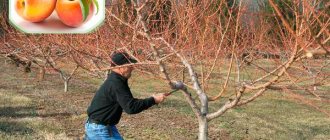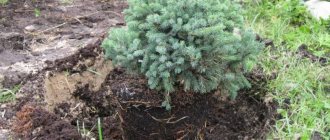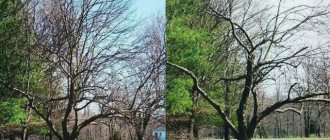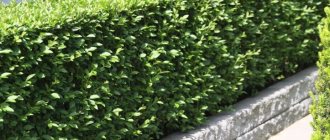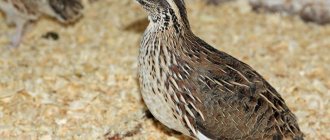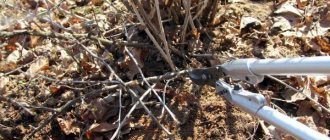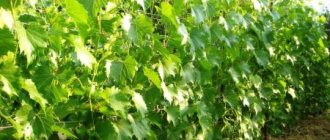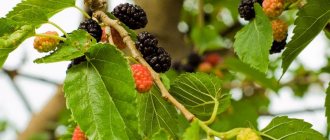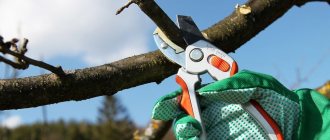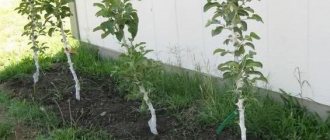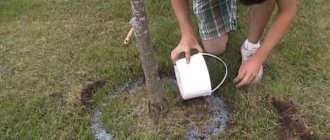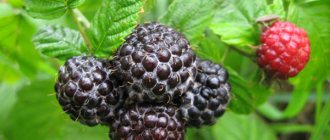Why is mulberry pruning necessary?
Mulberry trees are grown not only for harvest. They are very decorative, especially varieties with a weeping crown, so gardeners often decorate their summer cottages or local areas with them. And also the greens of the mulberry tree are used as a feed crop for the silkworm. For any of these purposes, pruning will be useful. It helps maintain the crown in a healthy state and allows you to correctly shape the tree in a certain way so that it is convenient to work with it in the future.
Pruning gives a powerful impetus to the development of new shoots, enhances lateral branching and the growth of green mass. As a result, the crown is denser, and the tree synthesizes more nutrients through photosynthesis. Timely cutting of old, diseased and damaged branches significantly improves the health of the tree, prevents diseases from developing, and reduces the number of pests. All these measures improve the decorative appearance of the mulberry and also increase its productivity.
We trim trees of different ages
The tree cannot be “started”; pruning must be done from the first years, otherwise later all attempts to form a crown may be unsuccessful. The main thing is not to get carried away; cutting the branches of a young tree too short can cause its death. But for old trees this is not dangerous; on the contrary, rejuvenating pruning will help improve the growth of mulberry and increase its yield. Moreover, this procedure will have a positive effect not only on the number of fruits, but also on their taste and size.
Types of pruning
There are several types of mulberry pruning. All of them are carried out to perform specific tasks and differ from each other. There are the following types of mulberry pruning:
- sanitary;
- rejuvenating;
- formative;
- decorative
Formative
Formative pruning is carried out in the first few years after planting a mulberry seedling. During this period, the mulberry is characterized by intensive growth; at this time, the foundation of the tree is laid and its skeleton is formed. Mulberries are planted not only to produce berries. It is often used in landscape design, as well as for technical purposes, as a food source for silkworm breeding. Depending on this, the mulberry is formed:
- Fruit tree.
- Decorative tree on a standard with a spherical crown.
- With a broom.
- A tree with a weeping crown.
- Custom.
The method of forming the mulberry crown also depends on the region in which the tree grows. The bush-like form is more winter-hardy, so this method is widely used in cold regions. Some mulberry varieties are distinguished by long annual shoots, and therefore have a predisposition to form a tree with a weeping crown.
Rejuvenating
Over time, mulberry yields can decrease significantly. It can be restored with the help of anti-aging pruning. This procedure is usually carried out over several years. During this time, the old wood is gradually removed, and new shoots are grown in its place, to which fruiting is transferred. At the same time, dried and broken branches, as well as diseased and pest-affected branches, are removed. Remove shoots that thicken and grow deeper into the crown, vertical tops and competitors. The interior space of the crown is brightened.
Sanitary
Sanitary pruning of mulberries should be carried out annually at least 2 times per season. This is early spring, when the tree has not yet entered the growing season, as well as autumn, the time after the end of leaf fall. During sanitary pruning, broken, dried and damaged branches are removed and the tree trunk is cleaned. Shoots that show signs of disease are also removed.
Reasons and rules for pruning mulberries
Is it possible to create a mini-version of an English park on the site? What to do if yields drop sharply? These and other issues can be resolved by trimming the crown.
When and why pruning is done:
- To rejuvenate the tree and increase its productivity. Gardeners prune the plant if the quality and quantity of the harvest noticeably decreases (for example, the fruits fall to the ground before they ripen, there are few berries or they become small, etc.). Removing unnecessary, infertile branches will “unload” the root system, which means that the mulberry will produce new fruitful shoots and direct nutrients to the formation of fruits. In addition, reducing the number of branches will facilitate pollination of flowers, which will increase yield (this is more true for young trees).
- For the purpose of disease prevention. An excessively thick crown of a tree can provoke the development of a fungus (powdery mildew, brown spot), which also affects other crops. Regular thinning of the crown will allow the branches to receive the required amount of sunlight, as well as avoid or significantly reduce the contact of healthy branches with diseased ones.
- When forming the crown. A correctly formed crown will provide the mulberry with the most favorable conditions for development and life. Pruning is used not only for practical, but also for decorative purposes.
There are several rules, following which, the gardener will save the tree from injury and damage during the procedures:
- Keep in mind that the purpose of pruning will affect when to do it. It is better to carry out sanitary work in the fall, and it is advisable to postpone rejuvenating or shaping until spring.
- If you want to shorten a shoot that has a bud, the cut should be made at an angle of 50°, 0.5–1 cm above it.
- If you are removing an entire branch, position the blade exactly perpendicular to the surface to ensure a smooth cut.
- Use special tools. For cutting thin shoots, no thicker than 2.7 cm, a pruner is suitable; for working with thicker branches (from 2.5 to 3.5 cm in diameter) or shoots located in hard-to-reach places, a lopper is suitable, and if you need to remove more larger branches, use a garden saw. Please note that it cannot be replaced with a regular carpentry tool, since the blade of the gardener’s tool is designed so as not to injure the tree during operation.
Correctly selected tools will simplify the pruning process and protect the tree from injury; the cut area must be treated with garden varnish
Be sure to disinfect garden tools after use with purified alcohol or fire to avoid transferring infections from one tree to another.
How to prune a mulberry tree correctly
To prune a mulberry tree correctly and not cause irreparable damage to the tree, you must follow certain rules:
- Trees can only be pruned at certain times of the year.
- For pruning, you must use only high-quality, well-sharpened and disinfected tools. Cuts left with sharp edges heal much better and faster.
- The older the trees, the more severe pruning can be done. Young trees must be pruned carefully, otherwise this may lead to their death.
- Green, non-lignified shoots can be broken off with your hands or their tops pinched, thereby stopping their growth if they are unnecessary or grow abnormally.
- When removing shoots “on a ring” or when pruning on a promising bud or shoot, it is necessary to follow the correct technique.
How to prune mulberries in spring
Spring pruning of mulberries is done when the threat of severe frosts is completely absent, otherwise the pruned shoots are guaranteed to freeze. This procedure can be started only after the air temperature has stabilized above - 10 °C. In the southern regions, mulberries can be pruned in early March, in more northern regions - in April. The exact time of spring pruning is chosen taking into account the climate of the region. It is important to have time to do this procedure before the start of sap flow, then the rehabilitation period for the mulberry will be minimal.
Mulberry pruning in spring includes all main types of work. At this time, the tree is sanitized, the crown of the young mulberry is formed, and work is also carried out to rejuvenate old plants.
How to prune a mulberry tree in summer
The scheme for summer mulberry pruning is very simple. As a rule, no major work is carried out at this time. The only exception is pruning decorative mulberries, the crown of which needs to be maintained in constant shape. At this time, only young growth that exceeds the dimensions is trimmed. At this time, you can limit the growth of green, non-lignified shoots if you plan to remove them in the future. To do this, simply pinch off their top with a fingernail. This measure allows the plant to direct nutrients to the growth and ripening of berries, and not to excessive shoot formation.
How to prune mulberries correctly in the fall
In autumn, mulberry pruning is usually carried out only for sanitary purposes. The tree is inspected and, if necessary, damaged and dried branches are cut out. Particular attention should be paid to the crown if the appearance of diseases or pests was noted on it during the season. Branches affected by fungus or other pathologies are removed, after which they must be collected and burned.
Common mistakes when propagating mulberries
When propagating mulberries, many people complain about rotting of the cuttings, and the rooting rate is reduced to zero. How to propagate mulberries to avoid loss of planting material:
- When cutting cuttings, use only disinfected tools.
- The whole process must take place very quickly, since the cut layers oxidize very quickly.
- After the grafting is completed, the joint must be covered with garden varnish.
- It should be noted that when propagating by seeds of deciduous species, it is impossible to obtain identical plants, since maternal characteristics are not transmitted to the seedlings.
- Mulberry can also reproduce on its own - by seeds, which germinate next year near the plant. However, you need to be able to separate new seedlings that have sprouted from seeds from the shoots.
Mulberries form shoots. This can be used in harsh winters, when the above-ground part of the plant freezes and root shoots replace it. Excess shoots need to be cut out or dug up and planted in a new place. The root shoots completely repeat the maternal characteristics.
vote
Article Rating
Mulberry formation by year
There are several schemes for formative pruning of mulberries in spring. Depending on the purpose of planting, the crown of the tree can be formed as follows.
- Crown of a fruit tree. In the first year, the seedling is cut to a height of 1 m. All other shoots are completely removed. In the second year of life, you need to select 3-5 of the strongest from the regrown side shoots, extending from the central conductor at an angle of 45 ° or more, located at a height of 0.7 m from the ground and above. All other shoots must be removed. The central conductor is cut off, leaving 4-5 buds on it above the upper lateral branch. The lower skeletal branches are cut to a length of 0.3 m, the upper ones must be shortened even further. In the third year, the tree is considered mature.
- Ball-shaped decorative crown. It is formed on a bare trunk at a height of 1-1.5 m. The central conductor is cut at a height of 2-4 m, depending on need. Side shoots are trimmed by 1/3 in the upper and lower parts of the crown and by ¼ in the middle. The main thing is that the crown is uniform in circumference and resembles a ball.
- Decorative "broom". Very beautiful crown type. First, you need to completely clear the trunk of side shoots to a level of 1-1.5 m from the ground. Then you need to select 3-5 strong lateral shoots that have a large angle of departure and are located at approximately the same height from the ground. The rest need to be removed. Selected branches are cut off by 4 buds. The conductor must be cut flush with the upper skeletal branch.
- “Weeping” crown. To form such a crown, it is necessary to grow the tree in a trunk to a height of 1.5 m. Each of the shoots growing higher is cut to 4-5 buds, which should be directed outward. Every next spring, all growing annual shoots are also pruned to 5-6 buds facing outward.
- This order is maintained until the crown is completely formed.
- Bush. Forming mulberry bushes is used in areas with unfavorable weather conditions. To form a crown of this type, it is necessary in the first year of the seedling’s life to select 3-5 strong lateral shoots extending from the trunk at a height of 0.15-0.4 m. They are cut to 4-5 buds, all other branches are removed. The central conductor is cut at the height of the upper skeletal branch.
- In the second year, the procedure must be repeated, selecting 3-4 more shoots. Last year's shoots are cut off by 1/3. In the third year, the bush should consist of 6-8 equivalent trunks. Weak side shoots and improperly growing branches must be cut into rings.
After the crown is formed in the required way, it is maintained in the required dimensions by pruning and thinning out the annual growth.
Important! In subsequent years, only sanitary and rejuvenating pruning is performed.
When is it better to prune and why?
Why prune a mulberry tree:
- The ability to give the tree a neat and well-groomed look.
- Rejuvenate the plant, which means increasing productivity.
- Remove branches that have lost their ability to bear fruit. And increase the likelihood of enriching young shoots with nutrients, which will later produce large, juicy and sweet fruits.
- Open up space for faster and more efficient pollination, which will improve yields.
- Give a chance for better penetration of sunlight, which will reduce the possibility of the formation of fungal diseases.
Professional gardeners agree that mulberries should be pruned while the tree is dormant. The best time for formative and rejuvenating pruning is the period from late March to early April, although depending on climate and weather conditions, the timing may shift. During pruning, a temperature of at least – 10 °C is desirable. Otherwise, the cuts will not heal well.
Attention. It is recommended to carry out sanitary pruning later. It is preferable to postpone it until autumn.
How to form mulberries in the Moscow region
The Moscow region is an atypical area for planting and growing mulberries. Its natural growth area is located south of the Kursk and Voronezh regions. However, it is quite possible to grow mulberries in the Moscow region and even further north. To do this, choose white mulberry varieties, such as White Staromoskovskaya, Admiralskaya or White Honey. Their winter hardiness is higher than that of red and black varieties. When planting, location is very important. It should be open and sunny, but at the same time well protected from the north and east winds.
The best results when growing mulberry in the Moscow region are obtained by forming it in the form of a low (up to 1.5 m) bush on a very short stem. This form makes it possible to bend the shoots to the ground and cover them for the winter. Sanitary cleaning is carried out in this region at the end of April or at the beginning of May, after removing the winter shelter. Autumn pruning of mulberries in the Moscow region, as a rule, is not done so as not to weaken its winter hardiness.
Mulberry planting
Planting a seedling on a site begins with choosing the appropriate time to complete the procedure and preparing the selected area. Like other fruit trees, mulberry can be planted in open soil in spring and autumn, although the latter option will be more appropriate for warm southern regions. In central Russia, or even more so in northern latitudes, it is better to plan planting for the spring months, so that young mulberries have more time to adapt to the soil before the onset of the cold season.
This will be especially relevant for the North and the Moscow region, where winters are early and very severe. The soil in the selected area can be sandy loam or loamy, but it must have a good drainage system, which will fully meet all the needs of this crop.
A few hours before planting mulberries, the soil mixture should be spilled with water (1 bucket per 1 hole), and further planting activities are carried out in accordance with the standard plan:
- The selected plant seedling is placed vertically in the hole and the roots are well straightened.
- Then, the hole is dosed with the remaining soil.
- At the end of planting, the substrate around the central part of the mulberry must be compacted well, moistened again and mulched with a 5-centimeter layer of peat or sawdust.
To prevent the trunk of a young plant from breaking during the initial stages of growing the plant, it should be tied to a peg driven nearby, and during winter planting, it should be additionally protected from rodents with roofing felt, fine mesh or any other solid material, with which the central part is wrapped almost until the branching begins.
Caring for the plant after pruning
Mulberry does not require special care; it is a very unpretentious plant. After pruning, it is advisable to only feed the plant a little. In the spring, this can be done by adding rotted manure, humus, as well as a complex nitrogen-containing fertilizer, for example, nitroammophoska, to the root zone. After autumn pruning, you can add a little superphosphate to the soil. Nitrogen fertilizers are not applied at this time of year.
Cut branches should be collected and burned, especially after sanitary pruning. They can harbor fungal spores, pathogens and insect pests. After this, the tree trunks must be whitened. This measure will prevent excessive heating and cracking of the tree bark under the bright spring sun. Whitewashing is also a good preventative against insect pests and their larvae that overwinter in cracks and folds of the bark.
Crown formation
The features of formative pruning of mulberry depend on its original age and time of growth on the site, therefore, in each individual case it may have its own characteristics.
In the first year of growing an annual seedling, it is shortened to a meter in height and all possible side shoots are removed. In the second year, the plant is left with 3–5 most developed and horizontally located shoots, located at a height of about 70 cm above the soil level (the remaining branches must be completely cut out). The central branch in this case should be 4-5 buds longer than the others, and the lateral and skeletal shoots should be longer than the upper ones (the lower ones are left 30 cm long).
The pattern of pruning mulberry shoots in the third year of their cultivation is not remarkable (you can repeat the actions of the previous year), and if the plant already consists of a central shoot and several well-defined skeletal branches, then it can be considered an adult and only sanitary pruning is performed with the removal of non-viable parts tree.
Forming a mulberry crown “on a fist”: a - cutting branches; b - formation of three “fists”.jpg
By observing the requirements for planting and further pruning the mulberry crown, you have every chance to regularly harvest abundant harvests of tasty and healthy mulberry fruits, which will not only strengthen the body’s immune forces, but also help improve your mood, which is also very valuable.
Propagation of seedlings
Mulberry can be propagated by seeds and vegetatively: layering, suckers, green and lignified cuttings.
Propagation by seeds
In the middle or at the end of October, mulberry seeds from the current year's harvest are cleared of pulp, kept for 1-2 hours in Epin solution (2-3 drops per 100 milliliters of water) and sown in the ground. If sowing is postponed to early spring, the seeds must first be stratified. It can be replaced by pre-sowing treatment: soak the seeds in cold water for 24 hours, and then another day in water at a temperature of 50-53°C.
In a sunny, unshaded bed, you need to make furrows and water them with water and fertilizer for fruit and berry crops. It is recommended to rarely sow small mulberry seeds to a depth of 3-5 centimeters, plant them in the ground, water them abundantly and mulch the soil. When sowing seeds in the fall, it is necessary to make a thicker layer of mulch so that they do not die in winter.
By autumn, the seedlings will become sufficiently developed and can be transplanted at a distance of 3-5 meters. A tree grown from seeds will begin to bear fruit in 5-6 years. Seed propagation has a significant drawback: seedlings may not inherit the characteristics of the mother plant or may not inherit them completely.
Reproduction by offspring
If the mulberry is frozen in the cold winter, the dead plant can be replaced by well-developed root shoots, on which a crown can be formed over time. Excess shoots are cut out or used as seedlings by digging up the shoot with roots and shortening it by a third. The offspring retain the characteristics of the mother plant completely.
Propagation by cuttings
Using an installation that produces a fine mist in a greenhouse, mulberries can be propagated from green cuttings. In June or July, when the mulberry begins to grow intensively, you need to cut cuttings from the shoots 15-20 centimeters long with 2-3 buds and plant them at an angle of 45° in the greenhouse.
Leave 1-2 top leaves on the cuttings with the leaf blade shortened by half and create a highly humid environment in the greenhouse. By the fall, the cuttings will send out new shoots and form a strong horse system, but they can only be planted in the ground next spring.
You can also root semi-lignified cuttings, cut at the same time and grown in the same way as green ones. They take root more slowly. The mulberry completely inherits the characteristics of the mother plant from cuttings.
Description of the plant
The mulberry tree or mulberry belongs to the Mulberry family.
It has a high growth rate at a young age, the tree reaches a height of 10-15 m. Mulberry has a powerful root system and a spreading crown. The leaves are alternate, heart-shaped with a sharp tip and jagged edges. The fruits are inflorescences of fleshy achenes 2-3 cm long, externally reminiscent of a blackberry. The fruits have a sweet taste and come in white, red, and blue-black colors.
Flowering occurs in April-May, fruits ripen in May-June. At the same time, the mulberry tree has unisexual flowers - staminate or pistillate.
Fruiting begins in the third season of the tree’s life; a full-fledged harvest ripens 5 years after planting. Mulberry is famous for its longevity - the tree usually lives up to 200 years.
In the Moscow region, mulberries are turned into bushes by pruning. This makes it easier to cover the plant for the winter. The mulberry tree can tolerate frosts of at least -30 degrees, provided there is a snowy winter. Frostbitten branches grow back, but freezing of the roots can lead to the death of the tree.
Pruning different varieties: features
Different types of mulberries are grown for different purposes, so their pruning patterns also differ. If a tree is planted to produce berries, then it is formed as a fruit tree. To obtain a large harvest, several fruiting tiers are formed. The distance between tiers is 50-60 cm. Trees planted for decorative purposes are pruned to obtain the desired crown shape. Decorative forms are popular not only among summer residents, but also among landscape designers. Due to the peculiarities of the pruning scheme, they bear less fruit, but have a beautiful crown. Main varieties:
- weeping or standard;
- pyramidal (formation of mulberry bush);
- spherical (in the form of a sphere, ball).
These varieties are distinguished by their unusual crown. Their large, bright green foliage turns yellow in the fall. When designing parks, these trees are often planted next to coniferous evergreens.
The most common variety of decorative mulberry: weeping or standard. Differs in compact sizes. It was bred mainly for decorative purposes. Thin shoots, like willow branches, cascade down to the ground. The weeping mulberry will decorate both the smallest summer cottage and a large park. The tree on the trunk begins to form in the 1st-2nd years after planting. All side branches are removed from the trunk, leaving them only at the top of the tree. In this way, a trunk without side branches 1.5-2 m high is formed. Young shoots are pruned above the 3-4th bud. In this case, the upper remaining bud should grow outward from the trunk. The upper branches then grow back and cascade down, forming a dome shape around the trunk. In the 3-4th year the procedure is repeated. At 4 years the tree should be fully formed. In years 4 and 5, leveling trims are made.
Further, this variety requires systematic thinning of the crown, since a large number of branches choke the growth of foliage. Excess branches are cut out, but the shape of the crown is left the same. Weeping mulberry will not suffer even from severe pruning. The length of the branches is shortened to 25-30 cm. The branches soon grow back and continue to bear fruit.
